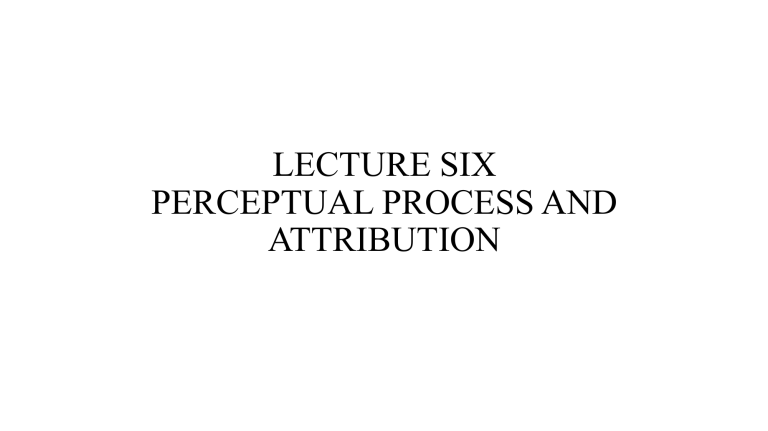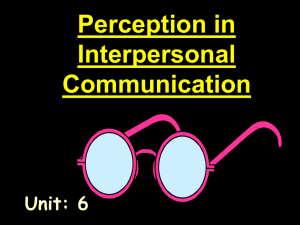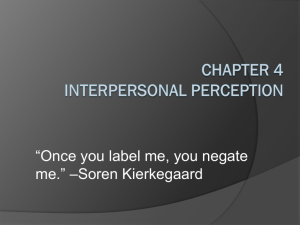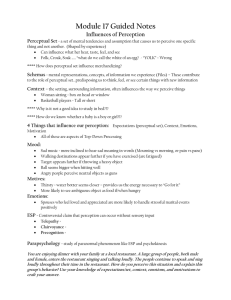
LECTURE SIX PERCEPTUAL PROCESS AND ATTRIBUTION MEANING OF PERCEPTION By perception, we mean the process by which one screens, selects, organizes, and interprets stimuli to give them meaning. It is a process of making sense out of the environment in order to make an appropriate behavioral response. Perception does not necessarily lead to an accurate portrait of the environment, but rather to a unique portrait, influenced by the needs, desires, values, and disposition of the perceiver. As described by Kretch and associates, an individual’s perception of a given situation is not a photographic representation of the physical world; it is a partial, personal construction in which certain objects, selected by the individual for a major role, are perceived in an individual manner. Every perceiver is, as it were, to some degree a nonrepresentational artist, painting a picture of the world that expresses an individual view of reality. The multitude of objects that vie for attention are first selected or screened by individuals. This process is called perceptual selectivity. Certain of these objects catch our attention, while others do not. Once individuals notice a particular object, they then attempt to make sense out of it by organizing or categorizing it according to their unique frame of reference and their needs. This second process is termed perceptual organization. When meaning has been attached to an object, individuals are in a position to determine an appropriate response or reaction to it. Hence, if we clearly recognize and understand we are in danger from a falling rock or a car, we can quickly move out of the way. Perceptual Selectivity: Seeing What We See perceptual selectivity refers to the process by which individuals select objects in the environment for attention. Without this ability to focus on one or a few stimuli instead of the hundreds constantly surrounding us, we would be unable to process all the information necessary to initiate behavior. In essence, perceptual selectivity works as follows. The individual is first exposed to an object or stimulus—a loud noise, a new car, a tall building, another person, and so on. Next, the individual focuses attention on this one object or stimulus, as opposed to others, and concentrates his efforts on understanding or comprehending the stimulus. For example, while conducting a factory tour, two managers came across a piece of machinery. One manager’s attention focused on the stopped machine; the other manager focused on the worker who was trying to fix it. Both managers simultaneously asked the worker a question. The first manager asked why the machine was stopped, and the second manager asked if the employee thought that he could fix it. Both managers were presented with the same situation, but they noticed different aspects. This example illustrates that once attention has been directed, individuals are more likely to retain an image of the object or stimulus in their memory and to select an appropriate response to the stimulus. These various influences on selective attention can be divided into external influences and internal (personal) influences. Exhibit one The Process of Perceptual Selectivity (Attribution: Copyright Rice University, OpenStax, under CC BY-NC-SA 4.0 license) Exhibit two Major Influences on Selective Attention (Attribution: Copyright Rice University, OpenStax, under CC BY-NC-SA 4.0 license) External Influences on Selective Attention External influences consist of the characteristics of the observed object or person that activate the senses. Most external influences affect selective attention because of either their physical properties or their dynamic properties. Physical Properties. The physical properties of the objects themselves often affect which objects receive attention by the perceiver. Emphasis here is on the unique, different, and out of the ordinary. A particularly important physical property is size. Generally, larger objects receive more attention than smaller ones. Advertising companies use the largest signs and billboards allowed to capture the perceiver’s attention. However, when most of the surrounding objects are large, a small object against a field of large objects may receive more attention. In either case, size represents an important variable in perception. Moreover, brighter, louder, and more colorful objects tend to attract more attention than objects of less intensity. For example, when a factory foreman yells an order at his subordinates, it will probably receive more notice (although it may not receive the desired response) from workers. It must be remembered here, however, that intensity heightens attention only when compared to other comparable stimuli. If the foreman always yells, employees may stop paying much attention to the yelling. Objects that contrast strongly with the background against which they are observed tend to receive more attention than less-contrasting objects. An example of the contrast principle can be seen in the use of plant and highway safety signs. A terse message such as “Danger” is lettered in black against a yellow or orange background. A final physical characteristic that can heighten perceptual awareness is the novelty or unfamiliarity of the object. Specifically, the unique or unexpected seen in a familiar setting (an executive of a conservative company who comes to work in Bermuda shorts) or the familiar seen in an incongruous setting (someone in church holding a can of beer) will receive attention. Dynamic Properties. The second set of external influences on selective attention are those that either change over time or derive their uniqueness from the order in which they are presented. The most obvious dynamic property is motion. We tend to pay attention to objects that move against a relatively static background. This principle has long been recognized by advertisers, who often use signs with moving lights or moving objects to attract attention. In an organizational setting, a clear example is a rate-buster, who shows up his colleagues by working substantially faster, attracting more attention. Another principle basic to advertising is repetition of a message or image. Work instructions that are repeated tend to be received better, particularly when they concern a dull or boring task on which it is difficult to concentrate. This process is particularly effective in the area of plant safety. Most industrial accidents occur because of careless mistakes during monotonous activities. Repeating safety rules and procedures can often help keep workers alert to the possibilities of accidents. Personal Influences on Selective Attention In addition to a variety of external factors, several important personal factors are also capable of influencing the extent to which an individual pays attention to a particular stimulus or object in the environment. The two most important personal influences on perceptual readiness are response salience and response disposition. Response Salience. This is a tendency to focus on objects that relate to our immediate needs or wants. Response salience in the work environment is easily identified. A worker who is tired from many hours of work may be acutely sensitive to the number of hours or minutes until quitting time. Employees negotiating a new contract may know to the penny the hourly wage of workers doing similar jobs across town. Managers with a high need to achieve may be sensitive to opportunities for work achievement, success, and promotion. Finally, female managers may be more sensitive than many male managers to condescending male attitudes toward women. Response salience, in turn, can distort our view of our surroundings. For example, as Ruch notes: “Time spent on monotonous work is usually overestimated. Time spent in interesting work is usually underestimated. . . . Judgment of time is related to feelings of success or failure. Subjects who are experiencing failure judge a given interval as longer than do subjects who are experiencing success. A given interval of time is also estimated as longer by subjects trying to get through a task in order to reach a desired goal than by subjects working without such motivation.”3 Response Disposition. Whereas response salience deals with immediate needs and concerns, response disposition is the tendency to recognize familiar objects more quickly than unfamiliar ones. The notion of response disposition carries with it a clear recognition of the importance of past learning on what we perceive in the present. For instance, in one study, a group of individuals was presented with a set of playing cards with the colors and symbols reversed—that is, hearts and diamonds were printed in black, and spades and clubs in red. Surprisingly, when subjects were presented with these cards for brief time periods, individuals consistently described the cards as they expected them to be (red hearts and diamonds, black spades and clubs) instead of as they really were. They were predisposed to see things as they always had been in the past Thus, the basic perceptual process is in reality a fairly complicated one. Several factors, including our own personal makeup and the environment, influence how we interpret and respond to the events we focus on. Although the process itself may seem somewhat complicated, it in fact represents a shorthand to guide us in our everyday behavior. That is, without perceptual selectivity we would be immobilized by the millions of stimuli competing for our attention and action. The perceptual process allows us to focus our attention on the more salient events or objects and, in addition, allows us to categorize such events or objects so that they fit into our own conceptual map of the environment. Social Perception in Organizations Up to this point, we have focused on an examination of basic perceptual processes— how we see objects or attend to stimuli. Based on this discussion, we are now ready to examine a special case of the perceptual process—social perception as it relates to the workplace. Social perception consists of those processes by which we perceive other people. Particular emphasis in the study of social perception is placed on how we interpret other people, how we categorize them, and how we form impressions of them. Exhibit three; Major Influences on Social Perception in Organizations (Attribution: Copyright Rice University, OpenStax, under CC BY-NC-SA 4.0 license) The way in which we are evaluated in social situations is greatly influenced by our own unique sets of personal characteristics. That is, our dress, talk, and gestures determine the kind of impressions people form of us. In particular, four categories of personal characteristics can be identified: (1) physical appearance, (2) verbal communication, (3) nonverbal communication, and (4) ascribed attributes. Physical Appearance. A variety of physical attributes influence our overall image. These include many of the obvious demographic characteristics such as age, sex, race, height, and weight. A study by Mason found that most people agree on the physical attributes of a leader (i.e., what leaders should look like), even though these attributes were not found to be consistently held by actual leaders. However, when we see a person who appears to be assertive, goal-oriented, confident, and articulate, we infer that this person is a natural leader.6 Another example of the powerful influence of physical appearance on perception is clothing. People dressed in business suits are generally thought to be professionals, whereas people dressed in work clothes are assumed to be lower-level employees. Verbal and Nonverbal Communication. What we say to others—as well as how we say it—can influence the impressions others form of us. Several aspects of verbal communication can be noted. First, the precision with which one uses language can influence impressions about cultural sophistication or education. An accent provides clues about a person’s geographic and social background. The tone of voice used provides clues about a speaker’s state of mind. Finally, the topics people choose to converse about provide clues about them. Impressions are also influenced by nonverbal communication—how people behave. For instance, facial expressions often serve as clues in forming impressions of others. People who consistently smile are often thought to have positive attitudes.7 A whole field of study that has recently emerged is body language, the way in which people express their inner feelings subconsciously through physical actions: sitting up straight versus being relaxed, looking people straight in the eye versus looking away from people. These forms of expressive behavior provide information to the perceiver concerning how approachable others are, how self-confident they are, or how sociable they are. Ascribed Attributes. Finally, we often ascribe certain attributes to a person before or at the beginning of an encounter; these attributes can influence how we perceive that person. Three ascribed attributes are status, occupation, and personal characteristics. We ascribe status to someone when we are told that the person is an executive, holds the greatest sales record, or has in some way achieved unusual fame or wealth. Research has consistently shown that people attribute different motives to people they believe to be high or low in status, even when these people behave in an identical fashion.8 For instance, high-status people are seen as having greater control over their behavior and as being more self-confident and competent; they are given greater influence in group decisions than low-status people. Moreover, high-status people are generally better liked than low-status people. Occupations also play an important part in how we perceive people. Describing people as salespersons, accountants, teamsters, or research scientists conjures up distinct pictures of these various people before any firsthand encounters. In fact, these pictures may even determine whether there can be an encounter. Characteristics of the Situation The second major influence on how we perceive others is the situation in which the perceptual process occurs. Two situational influences can be identified: (1) the organization and the employee’s place in it, and (2) the location of the event. Organizational Role. An employee’s place in the organizational hierarchy can also influence his perceptions. A classic study of managers by Dearborn and Simon emphasizes this point. In this study, executives from various departments (accounting, sales, production) were asked to read a detailed and factual case about a steel company. Next, each executive was asked to identify the major problem a new president of the company should address. The findings showed clearly that the executives’ perceptions of the most important problems in the company were influenced by the departments in which they worked. Sales executives saw sales as the biggest problem, whereas production executives cited production issues. Industrial relations and public relations executives identified human relations as the primary problem in need of attention. In addition to perceptual differences emerging horizontally across departments, such differences can also be found when we move vertically up or down the hierarchy. The most obvious difference here is seen between managers and unions, where the former see profits, production, and sales as vital areas of concern for the company whereas the latter place much greater emphasis on wages, working conditions, and job security. Indeed, our views of managers and workers are clearly influenced by the group to which we belong. The positions we occupy in organizations can easily color how we view our work world and those in it. Location of Event. Finally, how we interpret events is also influenced by where the event occurs. Behaviors that may be appropriate at home, such as taking off one’s shoes, may be inappropriate in the office. Acceptable customs vary from country to country. For instance, assertiveness may be a desirable trait for a sales representative in the United States, but it may be seen as being brash or coarse in Japan or China. Hence, the context in which the perceptual activity takes place is important. Characteristics of the Perceiver The third major influence on social perception is the personality and viewpoint of the perceiver. Several characteristics unique to our personalities can affect how we see others. These include (1) self-concept, (2) cognitive structure, (3) response salience, and (4) previous experience with the individual. Self-Concept. Our self-concept represents a major influence on how we perceive others. This influence is manifested in several ways. First, when we understand ourselves (i.e., can accurately describe our own personal characteristics), we are better able to perceive others accurately. Second, when we accept ourselves (i.e., have a positive self-image), we are more likely to see favorable characteristics in others. Studies have shown that if we accept ourselves as we are, we broaden our view of others and are more likely to view people uncritically. Conversely, less secure people often find faults in others. Third, our own personal characteristics influence the characteristics we notice in others. For instance, people with authoritarian tendencies tend to view others in terms of power, whereas secure people tend to see others as warm rather than cold. From a management standpoint, these findings emphasize how important it is for administrators to understand themselves; they also provide justification for the human relations training programs that are popular in many organizations today. Cognitive Structure. Our cognitive structures also influence how we view people. People describe each other differently. Some use physical characteristics such as tall or short, whereas others use central descriptions such as deceitful, forceful, or meek. Still others have more complex cognitive structures and use multiple traits in their descriptions of others; hence, a person may be described as being aggressive, honest, friendly, and hardworking. Ostensibly, the greater our cognitive complexity—our ability to differentiate between people using multiple criteria—the more accurate our perception of others. People who tend to make more complex assessments of others also tend to be more positive in their appraisals. Research in this area highlights the importance of selecting managers who exhibit high degrees of cognitive complexity. These individuals should form more accurate perceptions of the strengths and weaknesses of their subordinates and should be able to capitalize on their strengths while ignoring or working to overcome their weaknesses. Response Salience. This refers to our sensitivity to objects in the environment as influenced by our particular needs or desires. Response salience can play an important role in social perception because we tend to see what we want to see. A company personnel manager who has a bias against women, minorities, or handicapped persons would tend to be adversely sensitive to them during an employment interview. This focus may cause the manager to look for other potentially negative traits in the candidate to confirm his biases. The influence of positive arbitrary biases is called the halo effect, whereas the influence of negative biases is often called the horn effect. Another personnel manager without these biases would be much less inclined to be influenced by these characteristics when viewing prospective job candidates. Together, these factors determine the impressions we form of others. With these impressions, we make conscious and unconscious decisions about how we intend to behave toward people. Our behavior toward others, in turn, influences the way they regard us. Consequently, the importance of understanding the perceptual process, as well as factors that contribute to it, is apparent for managers. A better understanding of ourselves and careful attention to others leads to more accurate perceptions and more appropriate actions. CONCEPT CHECK How can you understand what makes up an individual’s personality? How does the content of the situation affect the perception of the perceiver? What are the characteristics that the perceiver can have on interpreting personality? Attribution Theory Attribution is what happens when a person takes the information they perceived and determines a reason as to what happened. What you attribute things like success to depends on your own perception and behaviors, which may be wrong due to being unrealistic or having the incorrect information for the situation. Things like bias and misconceptions can cloud that reasoning, which can interfere with a person's proficiency in the workplace and may contribute to issues with diversity. One of the concepts used in organizational behavior to help improve perception and attribution is attribution theory. The theory was first brought forth by psychologist Fritz Heider in the 1950s and stated that people had a desire to explain the reasoning behind their actions and the actions of others. It was expanded upon over the years by fellow psychologists Bernard Weiner and Harold Kelley, both of whom looked at the factors in a person's life that can impact their perception and their validity. They also looked at what impact certain attributions can have when a person acts upon them. Today, the theory is used to help people explain the causes behind human behaviors and largely make sense of them. In business, attribution theory is applicable to the members of a business' management team more so than it is to the standard employees. Managers are responsible for interpreting behavior and actions throughout the business to ensure that things are remaining as they should be and to keep an eye out for problems. If they make mistakes in their perceptions and attributions-or they are otherwise clouded by their own biasthen that can reflect throughout the company more so than if they were a regular employee. This is because it's the management staff that are the primary decision makers in the business' daily operations, and their power in the business gives them more control over it. Errors in their judgement and interpretation of things could end up wasting time and money for the business and could hurt the business' bottom line. It can also disrupt organizational behavior, as employees themselves could interpret management's response as hostile or incompetent. In some cases, an employee whose behavior is being misattributed by their supervisor and is being unjustly punished for it may feel like they are being singled out or victimized at work. As a result, their interactions with their supervisor and peers may become negative-especially if they do not feel like their co-workers are defending them or are even supporting the supervisor's views of them. Their work could undoubtedly suffer, as the punishments may infringe upon their allotted work time and decrease their production rate (which may result in more punishments). The same can occur if an employee is being unjustly rewarded for work or accomplishments that are not theirs to claim. The responsible party may feel like this is an ethics violation between coworkers, or they may receive some punishment when they come forward to claim their work because management doesn't believe them.






